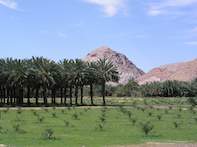Propagation
Propagation is from a seed, but this is generally not used as a commercially viable method because there is no way of producing uniform and true to type trees. Commercial producers would rather use rooted suckers or offshoots from plants that are healthy and more likely to provide true to type young palms.

These offshoots are planted out into a nursery area to develop and strengthen their root system and are only planted out after about 18 months. This makes this method laborious and expensive.
A more sophisticated method if available to growers is the use of tissue culture material which will assure virus free true to type plants. For this a tissue culture lab is required with suitable sanitary conditions in both the lab and nursery area. Tissue culture can produce many plants in shorter time and is therefore more cost effective.
Dates Planting Method
Level plant area and clean weeds. Mark out the rows and install the irrigation. Make a one cubic meter hole where the tree is to be planted (1mx1mx1m). Mix the soil from the hole with compost or manure or a mixture of the two and some Superphosphates and gypsum and return to the hole.
Leave for about a month to settle before planting the young tree. The soil must be kept moist after planting and to keep soil cool a mulching should be spread around the palm. If the salinity of the soil is slightly high then leaching irrigation should be implemented prior to planting. Make a 2 meter diameter basin around the young tree to ensure the water reaches the young Roots.
Spacing
Plants are mostly spaced 8 meters apart in rows that are 10 meters apart. This is about 120 plants per hectare. For better pollination one male plant should be planted for every 40 to 50 female plants.
Planting Time for Dates
Planting in the Southern Hemisphere and South Africa is normally in March when the temperature starts cooling.
Date Growth Period
It will normally take a Date palm almost two years to be ready to plant out into the field. Another four years to produce a reasonable crop and up to 12 years to reach full production of 80 kilograms and more per tree. Production can go on for 100 years but does decline at around 50 years.
Fertilisation
It is best to get the soil tested and a professional fertilizer recommendation procured from a local plant nutrition advisor or extension officer familiar with Date production. For flood or micro sprayer irrigation a good mixture for date palms available in South Africa is the N:P:K mixture 3:1:5 (26) Similar mixtures of organic slow release fertilizer is also recommended. If drip irrigation is used then a liquid fertilizer through the water is to be used.
A general nutrient requirement per date palm per year is approximately two kilograms of Nitrogen, one kilogram of Phosphorus and five to six kilograms of Potassium. There is consensus that almost 30% of the nutrients are lost so a 30 to 40% is added to the applications. The fertilizer is applied from May to December. Additional Phosphates and Potassium can be added in January and March if required.
Irrigation
Irrigation is by flood, micro sprinklers or drip irrigation. Dates require a lot of water and depending on where production is located and what method of irrigation is used will require between 15 000 m³ and 25 000 m³ of water per year. Drip irrigation is by far the most water wise.
While the trees are still young the leaves and core of the plant should be kept dry and sprayer irrigation directed away from the plant or stem. As the tree grows and the leaves are away from the ground this is no longer a problem.
For Southern Hemisphere trees the spread of water requirement is 50% from July to October over the flowering and fruit set period. From November to March 35% when the fruit develops and is harvested and 15% from April to June over the cooler Winter months.